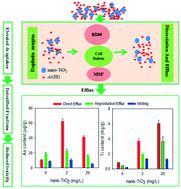当前位置:
X-MOL 学术
›
Environ. Sci.: Nano
›
论文详情
Our official English website, www.x-mol.net, welcomes your
feedback! (Note: you will need to create a separate account there.)
Insights into the uptake, distribution, and efflux of arsenite associated with nano-TiO2 in determining its toxicity on Daphnia magna
Environmental Science: Nano ( IF 5.8 ) Pub Date : 2020-02-27 , DOI: 10.1039/c9en01453e Zhuanxi Luo 1, 2, 3, 4, 5 , Zhenhong Wang 4, 6, 7, 8, 9 , Baoshan Xing 10, 11, 12
Environmental Science: Nano ( IF 5.8 ) Pub Date : 2020-02-27 , DOI: 10.1039/c9en01453e Zhuanxi Luo 1, 2, 3, 4, 5 , Zhenhong Wang 4, 6, 7, 8, 9 , Baoshan Xing 10, 11, 12
Affiliation

|
Only limited information is available on the effects of titanium dioxide nanoparticles (nano-TiO2) on arsenite (As(III)) accumulation and its ensuing associated toxicity in aquatic organisms. This study characterized As(III) uptake, spatial and subcellular distribution, and efflux under different exposure treatments and its toxicity on Daphnia magna in the presence of nano-TiO2. The results showed that the accumulated arsenic (As) content was significantly correlated to the corresponding accumulated titanium (Ti) content, implying that nano-TiO2 as a carrier increased As(III) accumulation in D. magna. In addition, a significant spatial correlation between As and Ti accumulation further confirmed the “carrier” role of nano-TiO2, while this role weakened under higher As(III) exposure levels due to its elevated toxicity and its limited adsorption capacity onto nano-TiO2. Also, despite the increase in As(III) accumulation, nano-TiO2 decreased D. magna toxicity. In particular, the 24 h As(III) EC50 increased from 2.53 to 2.97 mg As per L, while nano-TiO2 increased from 2 to 20 mg Ti per L. This reduction in toxicity resulted from the accumulation of most As in biologically detoxified metals (BDMs) and cellular debris as detoxified fractions. Moreover, the similarity in As and Ti subcellular distribution was clearly observed between 6 and 24 h exposure and between 75 μg As per L and EC50 exposure levels of As(III). Therefore, regardless of the exposure time or exposure As(III) level, the subcellular distribution of As can itself explain its toxic effects on daphnids resulting from As(III) stress associated with nano-TiO2. Interestingly, elevated nano-TiO2 produced lower As efflux from daphnids, which showed that nano-TiO2 still sequestered some As within this organism. Lastly, direct and reproduction efflux were the two main pathways that daphnids used to eliminate accumulated As and Ti. These findings can help us to better understand the ecological risks of nano-TiO2 and its co-existing contaminants in the environment.
中文翻译:

洞察与纳米二氧化钛相关的亚砷酸盐的吸收,分布和外排,以确定其对大型蚤的毒性
关于二氧化钛纳米颗粒(nano-TiO 2)对砷(As(III))积累及其在水生生物中的相关毒性的影响,只有有限的信息。这项研究的特点是在不同的暴露处理下As(III)的吸收,空间和亚细胞分布以及外排以及在纳米TiO 2的存在下对大型蚤的毒性。结果表明,砷的累积量与相应的钛(Ti)含量显着相关,这表明纳米TiO 2作为载体增加了D. magna中As(III)的积累。。此外,As和Ti积累之间的显着空间相关性进一步证实了纳米TiO 2的“载体”作用,而在较高的As(III)暴露水平下,由于其较高的毒性和对纳米碳的有限吸附能力,该作用减弱了。TiO 2。同样,尽管As(III)积累增加,纳米TiO 2降低了D. magna的毒性。特别是,24 h As(III)EC 50从每L的2.53 mg增加到2.97 mg As,而纳米TiO 2从每升Ti 2毫克增加到20毫克Ti。这种毒性的降低是由于生物解毒金属(BDMs)和细胞碎片中大部分的砷作为解毒级分的积累。此外,在暴露的6和24小时之间以及按照As(III)的L和EC 50暴露水平,在75μgAs和As之间,可以清楚地观察到As和Ti亚细胞分布的相似性。因此,无论暴露时间或As(III)的水平如何,As的亚细胞分布本身都可以解释其对与纳米TiO 2相关的As(III)应力导致的水蚤的毒性作用。有趣的是,升高的纳米TiO 2从水蚤中产生了较低的As外排,这表明纳米TiO2仍然在该生物体内隔离了一些砷。最后,直接流出和生殖流出是蚤形虫用来消除积累的As和Ti的两个主要途径。这些发现可以帮助我们更好地了解纳米TiO 2及其在环境中共存污染物的生态风险。
更新日期:2020-02-27
中文翻译:

洞察与纳米二氧化钛相关的亚砷酸盐的吸收,分布和外排,以确定其对大型蚤的毒性
关于二氧化钛纳米颗粒(nano-TiO 2)对砷(As(III))积累及其在水生生物中的相关毒性的影响,只有有限的信息。这项研究的特点是在不同的暴露处理下As(III)的吸收,空间和亚细胞分布以及外排以及在纳米TiO 2的存在下对大型蚤的毒性。结果表明,砷的累积量与相应的钛(Ti)含量显着相关,这表明纳米TiO 2作为载体增加了D. magna中As(III)的积累。。此外,As和Ti积累之间的显着空间相关性进一步证实了纳米TiO 2的“载体”作用,而在较高的As(III)暴露水平下,由于其较高的毒性和对纳米碳的有限吸附能力,该作用减弱了。TiO 2。同样,尽管As(III)积累增加,纳米TiO 2降低了D. magna的毒性。特别是,24 h As(III)EC 50从每L的2.53 mg增加到2.97 mg As,而纳米TiO 2从每升Ti 2毫克增加到20毫克Ti。这种毒性的降低是由于生物解毒金属(BDMs)和细胞碎片中大部分的砷作为解毒级分的积累。此外,在暴露的6和24小时之间以及按照As(III)的L和EC 50暴露水平,在75μgAs和As之间,可以清楚地观察到As和Ti亚细胞分布的相似性。因此,无论暴露时间或As(III)的水平如何,As的亚细胞分布本身都可以解释其对与纳米TiO 2相关的As(III)应力导致的水蚤的毒性作用。有趣的是,升高的纳米TiO 2从水蚤中产生了较低的As外排,这表明纳米TiO2仍然在该生物体内隔离了一些砷。最后,直接流出和生殖流出是蚤形虫用来消除积累的As和Ti的两个主要途径。这些发现可以帮助我们更好地了解纳米TiO 2及其在环境中共存污染物的生态风险。











































 京公网安备 11010802027423号
京公网安备 11010802027423号